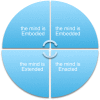Exploring Music-Based Rehabilitation for Parkinsonism through Embodied Cognitive Science
- PMID: 26539155
- PMCID: PMC4609849
- DOI: 10.3389/fneur.2015.00217
Exploring Music-Based Rehabilitation for Parkinsonism through Embodied Cognitive Science
Abstract
Recent embodied approaches in cognitive sciences emphasize the constitutive roles of bodies and environment in driving cognitive processes. Cognition is thus seen as a distributed system based on the continuous interaction of bodies, brains, and environment. These categories, moreover, do not relate only causally, through a sequential input-output network of computations; rather, they are dynamically enfolded in each other, being mutually implemented by the concrete patterns of actions adopted by the cognitive system. However, while this claim has been widely discussed across various disciplines, its relevance and potential beneficial applications for music therapy remain largely unexplored. With this in mind, we provide here an overview of the embodied approaches to cognition, discussing their main tenets through the lenses of music therapy. In doing so, we question established methodological and theoretical paradigms and identify possible novel strategies for intervention. In particular, we refer to the music-based rehabilitative protocols adopted for Parkinson's disease patients. Indeed, in this context, it has recently been observed that music therapy not only affects movement-related skills but that it also contributes to stabilizing physiological functions and improving socio-affective behaviors. We argue that these phenomena involve previously unconsidered aspects of cognition and (motor) behavior, which are rooted in the action-perception cycle characterizing the whole living system.
Keywords: Parkinsonism; brain plasticity; dynamic systems; embodiment; motor rehabilitation; music therapy; well-being.
Figures

References
-
- Horden P. Music as Medicine. The History of Music Therapy Since Antiquity. Aldershot: Ashgate; (2000).
-
- Needham N, Wang L, Robinson K. Physics. In: Needham N, editor. Science and Civilization in China, Vol. 4.1. Cambridge: Cambridge University Press; (1962). p. 126–228.
-
- MacDonald RA, Kreutz G, Mitchell L. Music, Health, and Wellbeing. Oxford: Oxford University Press; (2012).
-
- DeNora T. Music in Everyday Life. New York, NY: Cambridge University Press; (2000).
-
- Huron D. Is music an evolutionary adaptation? In: Peretz I, Zatorre RJ, editors. The Cognitive Neuroscience of Music. Oxford: Oxford University Press; (2003). p. 57–74.
Publication types
LinkOut - more resources
Full Text Sources
Other Literature Sources

